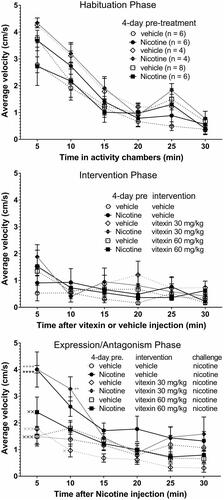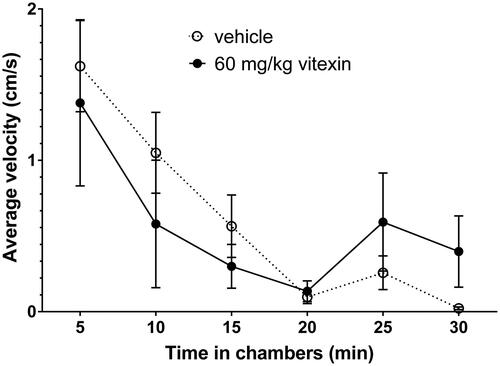Figures & data
Table 1. Results of HPLC-MS analysis of passion flower extract.
Figure 1. Time to habituation (left) and time course of the acute locomotor effect of nicotine or vehicle (right). To determine time needed to habituate, rats were placed in the spontaneous activity chamber and their activity recorded for 40 min (n = 18). At the end of 40 min, rats were injected s.c. with either the vehicle water (n = 7) or 0.4 mg/kg nicotine (n = 11) and placed back in the chamber for 60 min. Data shown are mean ± SEM for average velocity over each 5-min period. *p < 0.05, **p < 0.01, ***p < 0.001 for nicotine versus vehicle by 2-way ANOVA (time vs. treatment) followed by Tukey’s multiple comparisons test.

Figure 2. Antagonism of the expression of nicotine locomotor expression by vitexin. Rats were treated once/day for 4 days with 0.4 mg/kg nicotine or vehicle (water). At the end of the habituation phase, each rat was injected with either the intervention, vitexin or vehicle (DMSO: Tween-80: saline) and their activity measured for another 30 min (middle panel). Immediately following, in the expression and antagonism phase, each rats was given the challenge dose of 0.4 mg/kg nicotine s.c. and their activity recorded for another 60 min to assess sensitization and antagonism by vitexin (bottom panel). Only the first 30 min of the last phase is shown since there was little change in activity in any group after the first 15 min and no significant differences between groups after 10 min. Data shown are mean ± SEM for average velocity over each 5-min period. **p < 0.01, ****p < 0.0001 versus vehicle–vehicle–nicotine (control) group, and xp < 0.05, xxp < 0.01, xxxp < 0.001 versus nicotine–vehicle–vehicle (nicotine-sensitized) group by 2-way ANOVA (time vs. treatment) followed by Tukey’s multiple comparisons test.

Figure 3. The effect of 60 mg/kg vitexin on rat spontaneous activity. Rats were injected i.p. with either the vehicle (5% DMSO, 5% Tween-80, 90% saline) or 60 mg/kg vitexin and were returned to their home cages for 30 min before being placed in the spontaneous activity chambers and their activity recorded for 30 min. Data shown are mean ± SEM for average velocity over each 5-min period (n = 4 per treatment). No significant differences (p = 0.374) were observed by 2-way ANOVA (time versus treatment).

